Baptism By Fire: 1943 // Americans In Tunisia – Part One
March 12, 2018 by oriskany
We’ve all gone through the misery of playing a complex wargame for the first time. We just assume we’re going to get hammered the first few games. All we can hope for is that our veteran opponents might make a mistake? Show some hint of mercy? At least until we learn enough to make a better showing for ourselves?
Follow The Americans In Tunisia Series
Watch Our Preliminary Interview Above!
Now imagine this in actual combat, across hundreds of miles of desert, against the elite German “Afrika Korps.”
Although the Americans had entered World War II in December 1941, a full-scale showdown between the raw, green American Army and the grizzled, experienced German Wehrmacht didn’t actually take place for some time afterwards. Until such a battle occurred, no one really knew what would happen.
Well, here are two things that wouldn’t happen. The hardened veterans of the Deutsches Afrika Korps (DAK) - supported by other units like the 10th Panzer Division and the Italian “Centauro” Armoured Division - would not “make a mistake,” and they’d show no “hint of mercy.”
Project Summary
In this article series, we’ll take a “wargamer’s look” at the 75th anniversary of the American Army’s first large-scale battles against the Germans in World War II. These engagements would take place in Tunisia in February and March 1943 - just part of the desperate drama to characterize this final act of the North Africa campaign.
To play these games, we’ll use a brand-new sourcebook for the superlative Battlegroup system from IronFist Publishing. This is Battlegroup Torch, which is now available to pre-order, specifically detailing these last battles in the closing months of the desert war.
Working with Piers Brand (BOW: @piers), I was able to get a sneak peek at some of the scenarios, lists, special rules, and other materials for the Battlegroup Torch release. I don’t think it’s any secret that Battlegroup is my favourite WWII miniatures game, and I was very happy to hear about the new release just in time for this 75th-anniversary series.
We’ll also be taking a look at this “American Baptism” through the command-tactical eyes of Avalon Hill’s Panzer Leader, specifically the “Desert Leader” supplement published by Brain Train. By using this larger-scale system, we’re able to take a wider view of the battles and really get a “scaled” look at how they actually play out.
Tunisian Crucible
A Summary Background
By the time the Americans blundered into this fiery initiation, North Africa had been an active theatre for some time. Ever since the Italians invaded Egypt in 1940, steadily-growing armies of Italian, German, British, Commonwealth, Free French, and other Allied troops had see-sawed back and forth across hundreds of miles of desert.
The German commander, Field Marshal Erwin Rommel, had finally pushed his luck too far. Pinned down near a remote Egyptian rail station called El Alamein, he was decisively defeated in a series of battles raging from July through November 1942.
Meanwhile, the Allies were preparing another decisive move in North Africa. While the British Commonwealth smashed Rommel’s “Panzerarmee Afrika” in Egypt and chased it back across Libya, a combined British-American task force was about to land far to the west in Morocco and Algeria.
The basic idea was to slam the back door on Axis holdings in North Africa, cutting off their retreat. Morocco, Algeria, and Tunisia were Vichy French colonies, and thus under nominal Axis control. Rommel’s armies could not be allowed to escape into these territories, or the war in North Africa could drag on indefinitely.
Instead, “Operation Torch” would land a combined Anglo-American army at various ports in Morocco and Algeria. With these ports taken, a drive would then be mounted on Tunisia, closing on Rommel’s rear flank as he tried to retreat from Montgomery out of Libya.
The ultimate objective of Operation Torch was the port of Tunis. Once Tunis had fallen, and with the ports of Benghazi and Tripoli already taken in Libya, Axis armies in North Africa would be cut off from any hope of supply, reinforcement, or evacuation. They’d be pinned down in the open desert and destroyed utterly.
However, Operation Torch faced two major uncertainties. Firstly, no one knew how the Vichy French garrisons in Algeria and Morocco would react. As French, they were allies, but these were Vichy colonies…taking orders from a provisional government that was forced to toe the line laid down in Berlin. Technically, they were Axis troops.
Second, how the American Army would perform in large-scale modern combat remained a massive unknown variable. They had the numbers, for sure, and were well-trained, solidly supported, and fabulously equipped, with the full weight of the American industrial machine behind them. They were also fresh, eager, and anxious for battle.
But they were also undisciplined, impetuous, and perhaps most worrying…woefully inexperienced. There had been some combat in the Pacific and a detachment of Rangers had participated in the August 1942 Dieppe raid, but the troops (and more importantly, the officers) landing in Torch were completely new to the experience of combat.
Also remember that during this time, America didn’t maintain much of a standing army. When war came, a small cadre of regulars was massively reinforced by a flood of new draftees and volunteers. Officers had to be rapidly promoted (sometimes out of their depth) to command an army that had multiplied in size practically overnight.
Such concerns notwithstanding, Operation Torch was on. In October 1942, American convoys had to sail from as far away as North Carolina and Virginia, while British convoys sailing from the UK through the Strait of Gibraltar to reach the Algerian coast. On 8th November 1942, the landings finally took place.
Sure enough, there were plenty of problems. The amphibious landings were a disorganized mess, especially in the American sectors. American airborne drops were so far off-target that the paratroopers never really got into action. Worst of all, the Vichy French resisted bitterly, and American casualties against these allied troops were heavy.
In fact, one of the American commanders, Major-General George S. Patton III, took something of a bloody nose from Vichy French units in Morocco, especially at Casablanca and against a Vichy counterattack at Port Lyautey. American landings on Oran were actually counterattacked, again resulting in heavy losses.
Finally, Vichy French resistance was defused, more through political work with pro-Allied French leaders in these colonies than any military brilliance on the part of the British or especially the Americans. Hitler retaliated against this “betrayal” by invading Vichy France, thus ending the facade of Vichy “autonomy.”
Now the Americans and British raced eastward, trying to get into Tunisia and capture the all-important port of Tunis. Only 100 miles from Sicily, this port was the perfect supply point for Axis forces in Africa, and the final “back door” escape path for any German and Italian armies on the continent.
The Allies came close, and there were some small, sharp clashes of British, American, and “repatriated” Free French (formerly Vichy) forces against German defenders. But the Allies weren’t quite fast enough. American inexperience, Allied indecision, and torrential rains in December turned Tunisian desert into an uncharacteristic mud bath.
The Germans, in contrast, had acted with decisive resolve, quickly shipping reinforcements (eventually the whole Fifth Panzer Army) into Tunis to meet with Rommel’s Panzerarmee Afrika just pulling out of Libya.
As a result, Tunisia was transformed almost immediately into a formidable Axis fortress. Two German armies and one Italian army would soon be combined into “Army Group Africa” - deeply entrenched in mountainous terrain and fortifications in the south, and well-supported via Tunis along very short and easily-defended supply lines.
The Allies had missed their opportunity to end the North African war quickly. Now a whole new campaign would be needed to clear the Axis out of Tunisia, where these new American divisions would really get a taste for what World War II was like on a large scale … against some of the best soldiers the war would ever see.
Western Tunisia: Opening Moves
As the Allies started their operations in Tunisia in January and February 1943, they quickly found they had their work cut out for them. Montgomery’s Eighth Army coming up from Libya would be stalled by the Mareth Line, an old system of French fortifications along the southeast Tunisian border.
Meanwhile, Americans, British, and Free French forces approached from the west out of Algeria. These faced tough Axis opposition along a steep line of mountains that ran generally north-to-south down two great “spines” of the Tunisian landmass.
While Montgomery started to tangle with Rommel down at the Mareth Line, the Allies in the west made a series of badly-coordinated and half-hearted efforts to support him. These were handily defeated by units of the Fifth Panzer Army under Colonel-General Hans-Jürgen von Arnim.
In late January, von Arnim started a series of counterattacks against the Allies in the west. The first strike came at units of the Free French XIX Corps at Faid. They called to the American commander of II Corps, Major General Lloyd Fredendall, for armoured support. But Fredendall hesitated, and the French were overrun.
By the time General Fredendall finally mobilized an understrength counterattack (just Combat Command B of the 1st Armored Division), it was too late. The Germans by then were deeply entrenched at Faid, and these faint-hearted American counter-strikes were easily brushed aside.
By mid-February 1943, von Arnim was ready to hit the Americans the way he’d attacked the French. Striking out of his new position at Faid, he’d hit the American II Corps at Sidi Bou Zid on 14th February. This would be the first time in World War II that German and American ground forces had really come to blows on a large scale.
The results were, for the Americans, nothing short of tragic. But we’ll get into that in Part Two next week.
Now it’s time for you to tell us about your experiences playing desert battles on the tabletop. If you’ve been playing with the “best toys” like German Tigers, British 17-pounders, and American M10 tank destroyers, congratulations, you‘ve been playing in Tunisia. So share your “war stories” and observations below!
Most of all, please come back next week as the Americans start to undergo their “school of hard knocks,” tempered by fire from an eager mob of “noobs” into the hardened army that would help win the Second World War.
"By the time the Americans blundered into this fiery initiation, North Africa had been an active theatre for some time..."
Supported by (Turn Off)
Supported by (Turn Off)
"Now it’s time for you to tell us about your experiences playing desert battles on the tabletop!"
Supported by (Turn Off)





























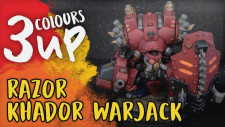





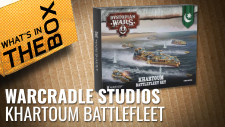





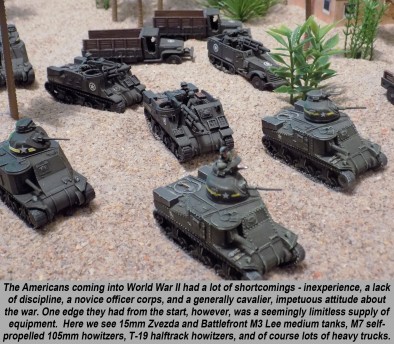
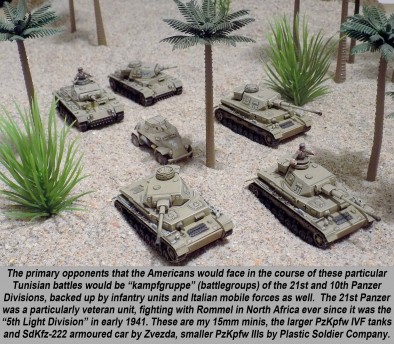
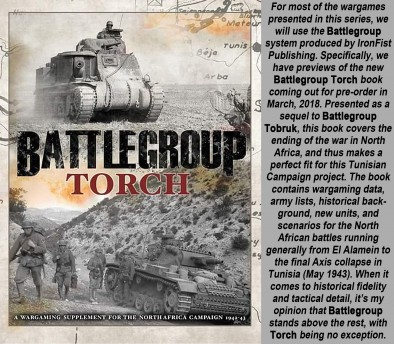
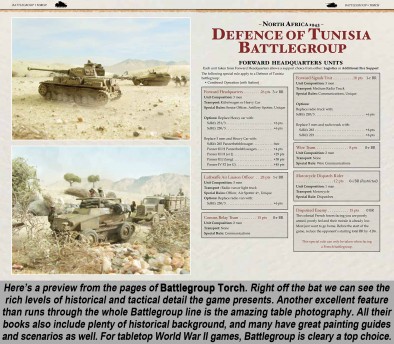
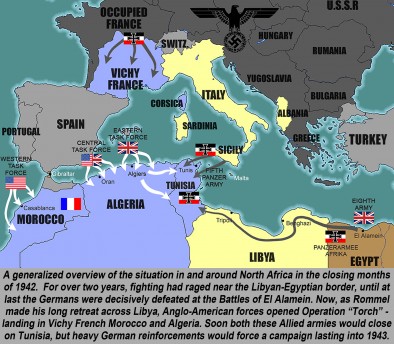
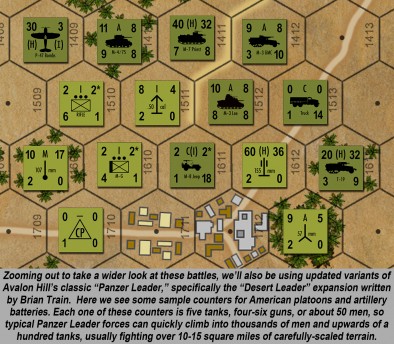
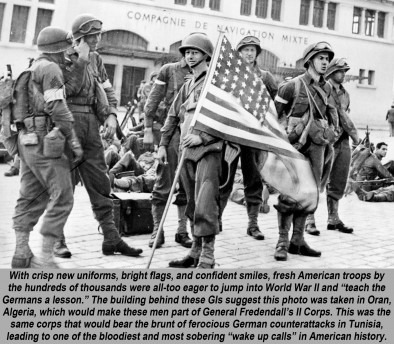
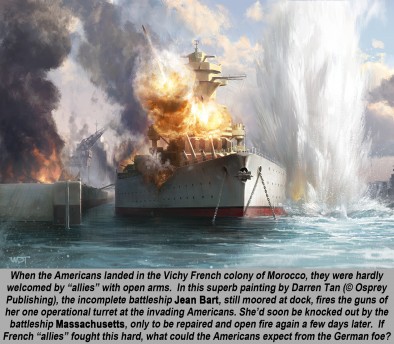
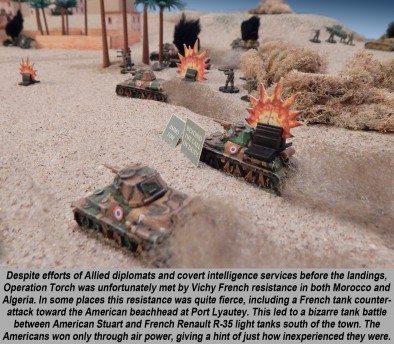
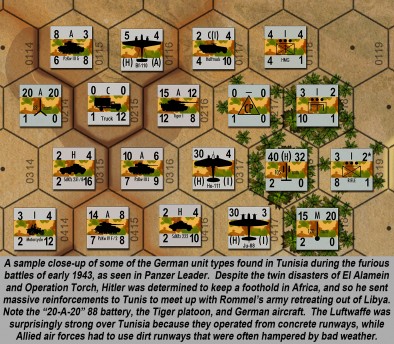
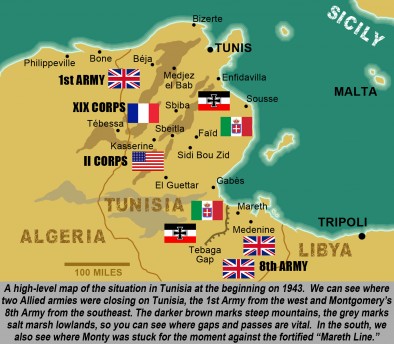
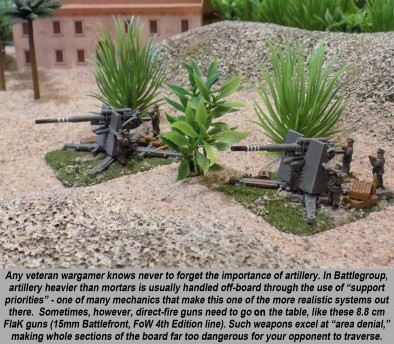
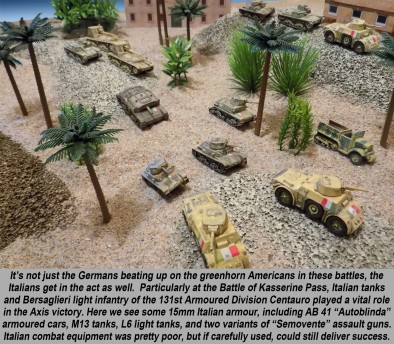
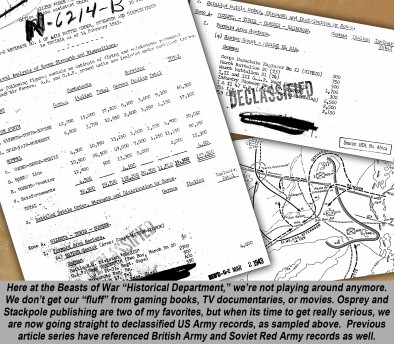



























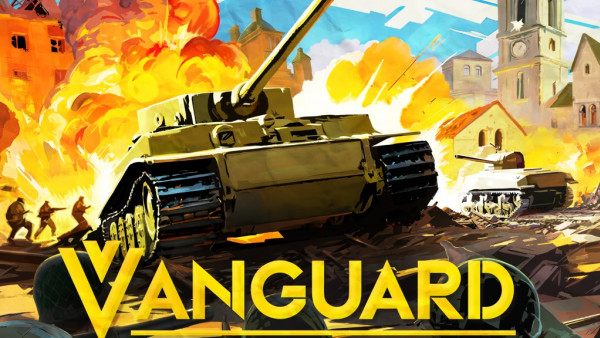
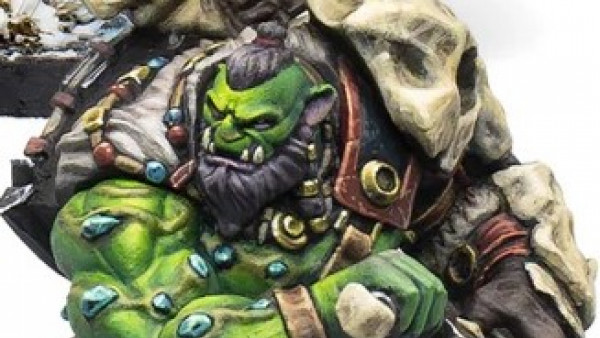
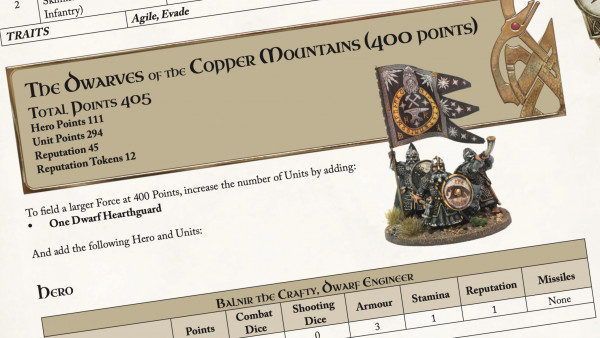




Looks to be another great series! My best source for this campaign was Rick Atkinson’s Army at Dawn which I just re-read in the new year. Lots of interesting points that could be drawn from that to guide gaming scenarios. – Highest command was occupied with political issues with French leading to poor coordination between different Allied forces and even parts of individual commands – Failure to concentrate forces and splitting off of a battalion here and there lead to under strength, mixed-nationality units – Allied air forces concentrated mostly on supply interdiction in Mediterranean resulting in local German air… Read more »
Thanks very much for kicking us off, @donimator – and with such a great comment! This is actually the second time Army at Dawn has been brought up, I’ll definitely have to check that out. To address your points specifically: 1) French politics: The Vichy/Free French issue is something we could talk about for months. It really was a tricky situation with Torch. To very quickly over-summarize: a balance had to be found on how much diplomatic effort to put into winning the Vichy colonial administrations over to the Allied side before the invasion, balanced against the need to operational… Read more »
Army at Dawn is a great read with a good balance of showing decisions and problems at the operational level, right down to those facing divisional commanders in the field. Follows key players throughout the campaign and has some very interesting observations on the relationships between them culled from letters and journal entries. Enough side information on what was happening with other Allied and Axis forces without drawing too much attention from the focus on the American forces. The other two books in Atkinson’s ‘Liberation Trilogy’ are quite good and well-reviewed – The Day of Battle: The War in Sicily… Read more »
@donimator – yeah, I know what you mean about gaming resources. There are tons of wars and battles, etc., I’d love to write about and have plenty to say about, but then I remember … oh yeah, I don’t have minis for that. Where would I get my photos? (We don’t just boost images off the net, unless (a) common use / public domain or (b) we specifically call out their source / copyright like with the Jean Bart painting above). Yeah, East had a little skirmish round about July 43. Not a big deal, just thought it would be… Read more »
In reference to number 3 The biggest issue with the Germans had was they could have rolled up western Europe and then decided to refit the most important aspect of their military’s need, Naval superiority. No one other than the Japanese had a navy of proper size. Carrier based air was proven to work nearly a decade before, thus with 2 island carriers in the Mediterranean, Malta and Gibraltar, this allowed the Allies to maintain both of these while keeping the Naval power in the North Atlantic. Germany could have taken the ports in the North of Europe and built… Read more »
Great points, @ghent99 – Operation Hercules, the German-Italian airborne invasion of Malta, is one of those interesting hypotheticals of World War II. Without this island standing on the neck of Axis supply lines into North Africa, it’s interesting to think what the effects its removal might have been, especially if undertaken early in the conflict.
Trying to take 50 pager from college and high point it. Lol
Went into North Atlantic wolfpacks vs Pacific US sub patrols and how the lack of naval fleet hampered with the Suez and stopping shipping.
The arsenal of democracy was allowed to be shipped wherever it was needed, even to China. Naval warfare is generally a strategic / economic system that the Germans skimped on. A navy is expensive but pays back as a huge investment once it is utilized.
Couldn’t agree more, @ghent99 . More of an educated guess here, but it feels like the Germans (or at least Hitler personally) thought of Germany as a land power with designs for a land empire (lebensraum, etc), so the need for a powerful navy was secondary. Of course, when you’re going to war with people that rely on naval power (the US but especially the UK), you need a navy to frustrate their efforts. Sounds like someone should have been reading Mahan’s The Influence of Sea Power Upon History. In Germany’s defense, their initial strategic vision included forcing the UK… Read more »
Looking good @oriskany
🙂
Thanks very much, @piers – and thanks very much for the preview of Battlegroup Torch! This really is another solid addition to the ongoing Battlegroup line.
I’d also like to thank @brennon for the flexibility support on the last minute changes in this article, and @lancorz on the great Backstage / Front Panel / Sidebar graphics. 😀 And of course all the work and web support I know Tom Guthrie puts into the back end of these publications. How can you not “look good” when you’ve got such a great team? 😀
Make-Up department always on the ball.
Making me look good … just not as good as @avernos ‘ hair. 😀
“Because I’m worth it …”
Looks like a start to another great series. Seems the American Army really did have some wrinkles to iron out, makes you wonder what might have happened if they went straight into France in 1942 as some of the generals proposed.
Probably similar to the Dieppe raid, but on a larger scale. There were a lot of hard lessons to be learned about invasion planning before Overlord could be executed.
Thanks, @pslemon – I have to concur with @damon . That said, I feel an invasion could have been pulled off in 1943. Sure, it would have been a bloodbath, a little like what the Soviets were going through in the east (still on a smaller scale, though). But it would have been a “real” second front, as opposed to Sicily and Italy, which were undertaken more to cater to British political and economic post-war fears, and never contributed meaningfully to any tipping of the scales in the East or really World War II in general. A Normandy invasion in… Read more »
Thanks, @damon – I think I covered everything I would say in reply in my response to @pslemon above . Dieppe was indeed a train wreck, and shows what happens when you launch amphibious assaults that aren’t only half-prepared, but you “have” to land at a port because you don’t have the logistical wherewithal to bring your own “ports” with you, or at least support a beachhead logistically from the shore. You never attack the port directly. Land on either side, invest from inland approaches (where there are usually no defenses), and just hop you can take the port intact.… Read more »
Dieppe has always been difficult to fathom; a propaganda exercise (back fired spectacularly), a trail run of invasion tactics (a really cold blooded move) or a distraction for a commando raid to ‘liberate’ a new Enigma machine from the nearby Kreigsmarine headquarters (this theory is new to me, still on the lookout for a reasonably priced copy of O’Keefe’s book ‘One Day in August: The Untold Story Behind Canada’s Tragedy at Dieppe’). Given the importance of Ultra this theory is intriguing, really want to read that book.
An early Overlord could have been worked against by British politics as well, needing a victory in North Africa etc. First in the name of Empire – see http://www.imdb.com/title/tt3554878/ an interesting show that can be found on Netflix in the US at least.
As always be careful this is just one interpretation of history by one historian
Awesome, @rasmus ! I actually found a YouTube link to this documentary as well, I will listen to it at work today. I like this narrator, his documentaries seem to be among the few “good ones.” 😀 😀
A solid start. I’m looking forward to a really interesting insight into the American contribution to the North African campaign. Bring it on
It was worth the sand all over the floors! The tables look GREAT. Also, I loved all the background information. This was a nice start to the series.
Whaaaaat? What sand on the floors? I swept up every grain! Seriously, learned a lot about setting up sand tables, and this series went much more smoothly in the ole’ “Casa Oriskany” than the previous desert series. 😀
Thanks for the comment! 😀
Yeah, and the tables were only up for a short time, compared to last time.
Indeed, all three games were set up, played, photographed, and torn down in something like six days. Definitely a hectic week. 😐
yay … it’s a desert …
I wonder if anyone will ever do something with this level of detail for 40k or any other fictional setting.
Or failing that … what about a newbies historical guide to the Mechwarrior universe ?
Well now, hold on, @limburger . Re: 40K, @Warzan and AJ used to do those 40K Uncharted discussions that went into incredible detail on the backstory of the 40K universe.
http://www.beastsofwar.com/40k-charted/
And as far as newbies’ historical guide to the Mechwarrior universe, I myself did a whole series on this a while back, with one article devoted exclusively to the lore, history, and backstory.
http://www.beastsofwar.com/battletech/exploring-part-two-backstory-setting/
Always happy to help. 😀
Finally a series I am not so embarassingly unfamiliar with 🙂 , but still there is allways something new to learn and condsider, f. i. the railway issue in Algeria and Tunisia. I had thought all transport had been executed by truck and halftrack. Some information I found interesting: Many people have the impression, from the movie, that General Patton played a very decisive role in the North African campaign. In one of my stuff it is said Patton was in North Africa, in command, just from 6 March until 15 April 1943. After that he was occupied with the… Read more »
Off the top of my head, I think there were approximately 30 Tigers in Tunisia. (I’m away from my books at the moment, at game club) Will have a look tomorrow night after work
I’m sure the numbers fluctuated up and down. All I know for sure is the “kompanie” attached from sPzAbtg 501 to Kampfgruppe Reimann, 10th Panzer Division. So a kompanie is supposed to be about 17 tanks, three platoons of 5, an XO and a CO, approximately. But this is a German company in 1943, so the number I’ve found most reliable isn’t 17, it’s about 5. 😀 But I’m sure there were other units with Tigers in Tunisia. I know, for example, sPzAbt 504 eventually shows up, this is where the famous Tiger 131 comes from before it’s captured at… Read more »
Thanks for the great comment – @jemmy ! 1) “I had thought all transport had been executed by truck and halftrack.” This is what I always thought, too. But I haven’t read the book @donimator and others reference, so I can’t say for sure. 2) “Many people have the impression, from the movie, that General Patton played a very decisive role in the North African campaign … So the movie leaves a wrong impression behind, I think.” This is absolutely correct. Patton commanded II Corps for a relatively brief window, and did it very well admittedly, turning a pile of… Read more »
Ramcke’s Fallschirm Brigade arrived to take part in the battles at El Alamein. His brigade consisted of 4 battalions, the 1st battalion commanded by Major Kroh, 2nd Battalion commanded by Major Baron von der Heydte, 3rd Battalion commanded by Major Heubner and the 4th Fallschirm-Lehr Battalion comanded by Maj Burkhardt. It gave a good account of itself in action but was almost destroyed in the fighting around El-Alamein and the retreat afterwards, only 600 escaped in captured trucks but found solace in the tobacco and goods the trucks were carrying, many were then caught up in the May 1943 surrender.… Read more »
Thanks, @Piers . 😀 Whenever someone asks me a question about fallschirmjaeger, I defer to you. Well, there you go, @jemmy . Oh, and to answer other questions, they would be all Tiger Is. Tiger IIs / PzKpfw VIbs didn’t show up until mid-late 1944, well after North Africa was well and truly wrapped up. Italian units had their own equipment, almost universally worse than the Germans. While they never had a Tiger, they did have a 90mm AA gun (Cannone da 90/53) that was used very much like the German 88 at times. Pretty solid antitank gun, but also… Read more »
Looking forward to this series. I’ve been digging through my piles of unbuilt plastic for kits suitable for this era Americans. I just wish Perry would do US infantry to match my Germans and Brits.
Thanks very much, @koraski! 😀 American equipment in this period really is an interesting (if sometimes deplorable) mess. The M3 Lee is just a horrible glory, so tall and with all those rivets to pick up your drybrushing! 😀 And of course there are the *cough cough* … “tank destroyers” in the form of the M6 Fargo GMC … the only real tank destroyers available to the 701st TD Battalion at Sidi Bou Zid …
https://www.flamesofwar.com/hobby.aspx?art_id=2652
Fully agreed!
@jemmy – “Fully agreed” about the Perry kits or about the deplorable state of American equipment? The ironic thing is, one of the reasons American units like self-propelled artillery (armored artillery regiments) and especially tank destroyer battalions were so under-equipped was the volume of Lend-Lease equipment sent to the British, especially in 1942. Specific examples would be the vast pile of M4 Shermans and M7 Priests sent to Eighth Army just after the Fall of Tobruk. Winston Churchill was actually in Washington DC, sitting in FDR’s office when the news of this came in, and FDR by executive order immediately… Read more »
I meant the Perry infantry plastic kits for 28mm. They have Afrika Korps and 8th Army for Africa. As I believe the American infantry in Africa may have looked a bit different from that from other theatres, it´d be nice to see some American infantry in African attire and equipment, the latter only, if it differs much. At least that´s also how I understood our friend @koraski . Thank you, @oriskany , for the heads-up on availability of armoured equipment for the US Forces in the early part of the North African campaign. FoW doesn´t mention much of this, M7… Read more »
No worries, @jemmy .
In all fairness to Battlefront / FOW, they certainly do offer units like the M6 GMC:
https://www.flamesofwar.com/hobby.aspx?art_id=2652
… I just don’t know where they appear in any of the books. I’m sure they do somewhere.
Meanwhile, some American units in Tunisia do have the M7 HMC (“Priest” by the British) – they’re just very rare and not included in the units specifically under discussion in this series, during the timeframe under examination.
@jemmy I did indeed mean plastic 28mm North Africa equipped Americans. I’d settle for some metal ones in fact. My problem is the Perry’s infantry are true scale while warlords are kind of bloated “heroic” scale so they don’t look quite right together on the same table. I have settled for some of the old Wargames Factory plastic Americans. They are still available through Dreamforge games webstore (WF ended their retail business and partnered with Warlord for most of their miniature lines, except the WW2 15mm and 28mm infantry kits which are now only available via Dreamforge). The scale is… Read more »
I’ve recently been using a lot of Old Glory metals in 15mm. Not bad, for metal, easily available here in the States, and they are responsive and easy to reach if you have to expedite an order. The vehicles are pretty good. And inexpensive. They have the old-school heavy metal tank feel. The Infantry are well-detailed, I’m just not sure some of the details are that accurate. My Vietnam US infantry was really just WW2 infantry with M16s, and my NVA platoon all came wearing shorts (??) But I’m building my M48A3 Pattons at the moment and they are excellent.
@oriskany I’ve got several boxes of Italeri 1/72 Vietnam figures. Combined with their excellent helicopter line of models and a boatload of aquarium plants I’ve got another “someday” project…
Sounds epic, @koraski – Like you, I sat down one day with a tub full of plastic jungle plants (got mine at the craft store, but I’m sure they’re pretty much the same thing) and just built jungle terrain for 2-3 days. Now I have a pretty substantial “jungle box” – enough to pretty much blanket a 6×4 table. Best of all, because it’s mostly plastic, it should survive in my outdoors storage pretty well (humidity here in Florida destroys just about anything not metal or plastic). I hope you post your 20mm Vietnam armies someday! 😀 1/72 helicopters are… Read more »
A nice start to the week @oriskany I never knew the US got such a bloody nose from the French from the very start.
Thanks, @zorg – to be fair to the Americans, diplomatic efforts were underway to get the French back on the Allied side, so these landings were undertaken without a lot of preparatory naval barrage or air bombardment. When they came ashore the Americans weren’t 100% sure if they were going to be opposed or not … so they went in kind of “soft.”
And of course, they were woefully inexperienced, and these first big amphibious landings were badly disorganized and there were a whole host of other problems.
Fortunately, the fighting was sharp, but mercifully brief.
I was trying to think had the French fleet been attacked in Africa at this point?
Short answer, @zorg – yes. Detailed answer . . . (draw deep breath) . . . Yes, there is main attack that many have heard of on July 3, 1940 – at Mers-el-Kebir in Algeria. Obviously this was long before the Allied landings at Torch, in fact it was right after the French surrender after the Blitzkrieg of the west. In summary, the British were afraid that this massive French battle fleet in Mediterranean and south French ports might fall into German or Italian hands. The British sailed up, demanded that the French surrender to them, and when the French… Read more »
yeah and when the Germans did try and take the remaining ships the crew scuttled them.
Oh, absolutely @zorg . I don’t remember the percentage at Toulon, but it was definitely the vast majority of the fleet was scuttled so it wouldn’t fall into German hands.
501 had 20 Tigers and 16 Panzer III on the 10th November 1942 when they entrained for Reggio in Italy. The first three arrived at Bizerta on 23rd November, the crews having already flown over to Tunisia. During December they return a static seven operational Tigers and 5 Panzer IIIs. At the end of that month further arrivals raise it to 12 and 16 respectively. In January 43 the 2nd Companies 8 Tigers arrive, but by the end of the month the returns are 11 Tigers and 14 Panzer IIIs operational. The numbers in service vary widely over the next… Read more »
Great information, @piers . 😀 I only have Tigers appear once in this series, with Kampfgruppe Reimann / 10th Panzer (which, according to my sources: included “one company of sPzAbtg 501” … but doesn’t say which company). These appeared vs. CC A / US 1st Armored Division at Sidi Bou Zid. American action reports submitted in late February / early March suggest “about five of the new Tigers.” Of course in our Part 02 Battlegroup Torch game, Tigers are “unique” anyway, so I only took one (plus I only have one miniature and even that one isn’t terribly good). 🙂… Read more »
Great read as always – an interesting part of the war
Thanks very much, @rasmus – and I agree it’s an interesting part of the war … with the Germans and the Allies being a little more evenly matched. By the time you get into France or subsequent operations, it gets much tougher to find campaigns where both sides have a historically realistic chance of local tactical (i.e., gaming table) success. Exceptions would include Lorraine and Market-Garden.
Nice read, I like senerios with the historical equipment ( not all tigers / panthers) and yes armies need to practice and learn, as history has shown us the devil is in the details ( eg- find the right beach?)
Also thoughtout the war the various airforces struggled to put the paratroopers where they were supposed to go, and not drop them from too low an altitude, (soar point)
Wow this is incredible @oriskany . I’ve been playing a lot of desert Flames of War mainly British v Germans but a few games with American’s and the difference is pretty huge. Better equipment but less skill totally changes the way you play. I’m three quarters through reading “Panzer Commander” by Hans von Luck. He served as Rommel’s main recon Battalion Commander and while he mostly talks about the British he was very wary of American equipment especially Grants and Shermans. Unfortunately he was sent on a mission to personally plead with Hitler to let the Afrika Corps retreat and… Read more »
Another great series and one of the campaigns that i have revisited on many times. At the tactical level there are many opportunities to recreate historical battles, not just the operational level. So, bolt action guys can get some love too. I would like to insert two facts concerning the 1st Armored Division (US). One, due to Operational Deployment considerations the Division never fought as a cohesive unit, often finding its Combat Commands fighting different battles separated by large distances. Two, the condition of 1st Armored. For political reasons the Division was sent to Northern Ireland without training, expected to… Read more »
@irondragon6 – You are absolutely right about 1st Armored’s piecemeal deployment, and this is definitely something we cover in Parts 02 and 03 of this series. The “Combat Command” idea of semi-permanent mixed-arms brigades worked well for the Americans through the rest of the war, but here I think it was still taking shape. Case in point, the usual “40-40-20” template of CC A, CC B, and CC R (reserve) was not being used here. There were A, B, C, and I swear some US Army records of the time show a Combat Command “D”. (?!?!?) Furthermore, CCA and CCB… Read more »
@oriskany, good start again mate, loved the picture of the Jean Bart. Read a book on Torch not long ago , think it may have been ‘The last War with France’, tried to find it in my Kindle library, but think I may actually have the physical copy. Did read recently that the American supply line got so fubar in Tunisia that some units were actually wearing British winter clothing supplied by 1st Army. Do have a picture in my library of a British armoured car regiment, the Durham I think being lent to one of the U.S divisions as… Read more »
Thanks, @bobcockayne , and great comment! 😀 There are indeed a lot of photos of some rather shabby-looking American soldiers and even officers, many of them wearing greatcoats. Not sure where they’re from, but these Tunisian battles took place in conditions that were sometimes actually quite cold, rainy, and muddy – as opposed to the “sweltering North African desert” we often imagine. I would be interested in reading / seeing more on that Durham. I was trying to build a complete OOB for CC A / 1st Armored Division at Sidi Bou Zid, which includes the 81st Armored Recon Battalion.… Read more »
I will at the weekend dig out the inf on the Durhams(though may have wrong count), and try and copy the photo of them. It was in a pictorial book , Tanks in the Desert’ , tons of pic but not a lot of info, but one of those books that you sit for hours pouring over the pictures. This of course gives me the excuse to do it again, blobbed out on the couch with a cuppa and snacks. So it will be a peasure to find it. Knew most of what you said about the 75 variance, which… Read more »
Thanks, @bobcockayne – I’d appreciate it! I love strange equipment and vehicles in units, especially in Panzer Leader (where you can just make a counter for it, it can be a little more work to accommodate that kind of thing in a full-blown miniature). I’m working up the Battle of El Guettar for Part 04, where 90th Artillery Regiment / 10th Panzer Battalion reportedly had at least one battery of captured British 25 pounders. Not 100% sure if those guns were actually involved in El Guettar, but I’m including them under “the Rule of Cool.” 😀 I do remember seeing… Read more »
Well Jim found the book in question, it was a Tank Museum publication. Funny how memory plays tricks on you, Unit that help american units with Recon was not the Durhams, but the Derbyshire Yeomanry, who were nominally part of 6th Armoured division (mailed fist). The picture shows and the text confirms they were mainly equipped with both Daimler Scout and Armoured Cars, and were rated by both Americans and British units as being really good at their job. The book also shows the early Sherman with the L30 , looks odd as they put a similar counter balance on… Read more »
Gotcha, @bobcockayne – yes, we definitely bring in 6th Armoured Division, 26th Armoured Brigade, “Nickforce,” etc to Part 03, where we highlight the British action along the northern shoulder of the Kasserine Pass battle. Battlegroup Torch has a 2-page spread picture of a German mechanized column, and until I read the caption I swore it was American, it had so many M3 halftracks. I was like: “oh look, those Americans have a captured German armored car, and a tank, and a halftrack, and … hey, wait a second, those are GERMANS! But 60% of their column is American equipment!”
Informative read @oriskany . I like the small scale miniatures battles augmented by the larger Panzerblitz scale scrums. Have you ever campaigned anything using a macro Panzerblitz (or I suppose, more accurately Panzer Leader) board for maneuver and setting up clashes, and then played out those games in Battlegroup or FoW?
Great question, @cpausl1 – actually no, I’ve never done this. Part of the reason I believe would be a 6′ 15mm table would represent about 600 feet, roughly 200 meters, or less than one Panzer Leader hex. More accurately, the “border area” between two hexes, as one 2-3 counter stack of units overruns / CAT attacks another stack of enemy units. In this way, you get 4-6 platoons fighting each other on a table, or the representation of a Battlegroup / FOW game. In an actual Panzer Leader table, as I’m sure you know, this almost never happens. Enemy hexes… Read more »
Here are some harsh words but they are historically accurate. Officers need to learn how to get their men killed the right way for the correct result. They make decisions from the Generals and staffers to the juniors that lead to the deaths of many soldiers, it is truly what lessons are learned from the failures to make the winning decisions. Every decision was going to lead to death, was there value in doing or in not doing something, these are the hard questions asked in the entry of the U.S. into the shooting war. The Germans learned first and… Read more »